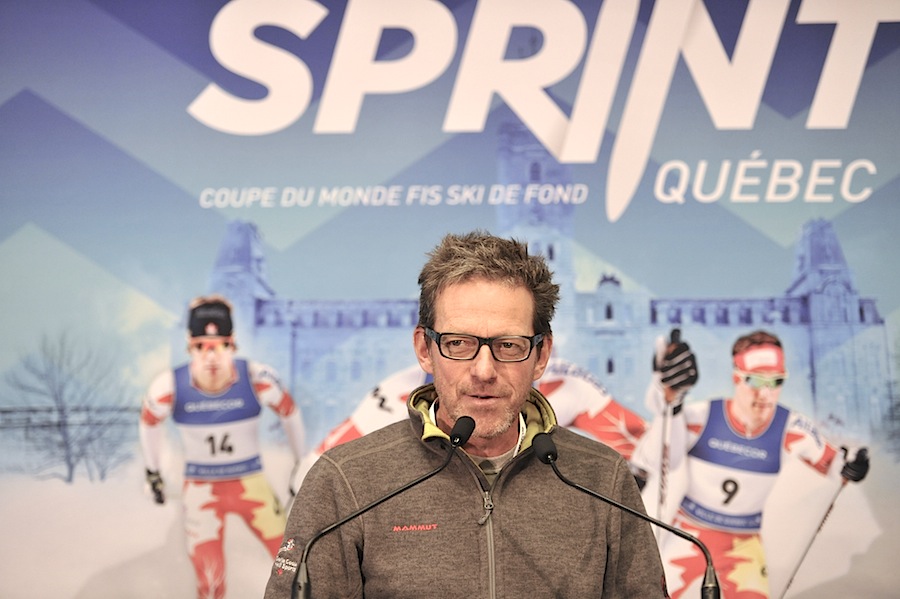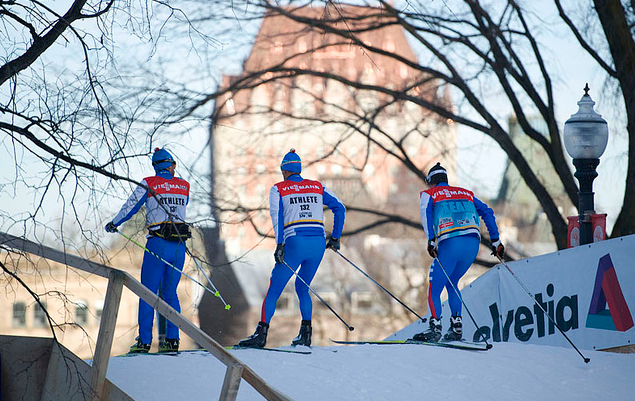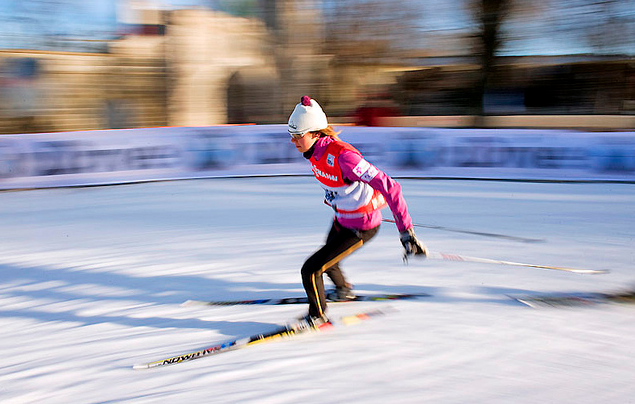
QUÉBEC CITY – When Gestev president and CEO Patrice Drouin agreed to host the first cross-country World Cup in Québec in the summer of 2011, he wasn’t entirely sure what he was getting himself into. He had never held a nordic race before, but with plenty of experience in other unique sporting events – Red Bull Crashed Ice, Mountain Bike World Championships, etc. – the Québec-based organizer was sure he could deliver.
What came next was a slew of meetings, administrative hoops and headaches over Mother Nature that might scare some from heading a similar event again. Yet as Drouin reflected on the two-day World Cup and the preparation leading up to it, he appeared relaxed. Sure, he had FIS Snowboard World Championships up next Jan. 16-27 and was operating on about four hours of sleep, but that was more than he usually got during his high-profile events.
While Sprint Québec required a significant investment (around $2.5 million) and learning curve to meet International Ski Federation (FIS) standards, Drouin said it was undoubtedly a success and he’s excited for the next cross-country World Cup planned for 2016. FasterSkier found out more in an interview Saturday night.
FasterSkier: How did the event go overall?
Patrice Drouin: We went from the beginning of the organization of it, like Day 1 on site November 6, which we started to make snow. From there we went from a good plan to maybe one not at all because we had no snow. But then everything came together recently about 10 days ago, we had the snow. So that was, for us, the biggest challenge. When you sign on for an event like that a year and a half ago, December 7 and 8, you feel confident that you will do that but when it comes closer and closer and you don’t have snow …

FS: Did you consider moving it to Mont Sainte-Anne?
PD: We had some backups, but the original plan was really our focus. To take it away from here and bring it to a ski resort at the last moment would be a disaster. We felt we would achieve something doing it here, but our biggest challenge was really dealing with cross-country at FIS. It’s totally new for us, it’s really different … it’s very detailed, technical things and we are not used to it. We can improvise a little more in the other sports, we can change things, we can be a little more creative. This is formatted, you know? You follow a format.
FS: How was working with FIS?
PD: That’s fine for us. What we went through is a normal process of getting used to something. New ground’s slippery sometimes but you manage to get through so that’s what happened. The result is amazing, above my expectations, really.
FS: How did you go about getting a jump, or step down, approved for the first time in a World Cup sprint?
PD: The first idea was to try to innovate and do something different and that was our goal and I proposed it to Pierre Mignery, the FIS [race director], at the FIS Congress. He went to the FIS cross-country ski commission and he got the approval of trying it here. I said, ‘OK it’s just maybe a step for the sport in one direction’ and just the fact that the athletes respected that and did play with it is already is something. It’s a small thing but maybe one day we can do bank turns because the sport is fast, very challenging and we must work on the courses to make it extremely nice. This will evolve in a year, just the jump is a little thing. It’s not very relevant at the moment but it will be in the future I’m sure.
FS: We heard your inspiration came from mountain-bike courses. Is that right?
PD: That’s the way we designed the course here because my background is mountain bike. When I design mountain bike courses, it’s a mixture of different elements and I felt comfortable to think about delivering this type of course. First of all, when you do a first drawing and you give it to an athlete like Alex [Harvey], he knows the place so he comes to me and says, ‘That’s very much feasible, you know, it’s OK’. The curves need to be defined but the sense and the orientation, [but] he felt it was fine as a point of view of a racer so that told me we were in the right direction so we proposed the course and the location to FIS. But where do you start with a concept like that? There is no books about it, you must design it, you must think about this and that.
FS: What did you learn from this event, and what would you change in the future?
PD: Crowd circulation, giant screens, you know, bigger, more screens. But it’s just a matter of budget. We had to deliver it in the right way and it’s a free event, nobody pays. Who pays? We invested a lot of money and we decided to deliver, there were three screens, so we are fine with three screens at the moment. For sure, some people didn’t see a lot, that happens at many sports events. But I think public flow around the track, access to all areas, televisions with screens, and the athlete village a little bit closer to the track and wax cabins maybe closer. We’ll read a lot of notes in post-event report from all the staff. For the media to watch at the finish, we would put some screens so people can work from their location preparing for the finish, watching the race.
FS: How many spectators were there?
PD: We will have final results of our studies in about two months. We had people taking notes and counting and asking questions for where people come from and things like that. We had about 50,000 people for the whole event, this is people passing by the venue. On Friday, we had a crowd in the morning, we had a crowd at noon for lunch and we had a crowd for the finals in the afternoon, so we had three different crowds [and] we evaluate all. And plus the family site a little bit above on the street, the initiation site for kids, so we had special group there that probably never got [to the race venue] so we calculate the circulation. We believe we reached about 50,000 in the whole event.
That was pretty much our goal. When we started to sell the site to sponsors, we were thinking of the site being able to accommodate 75 [thousand] so this is how we based the projection: 75,000 people total, but publically we hoped to get 50,000 so we are in between. Not reaching 75,000, it’s not a problem, there’s no sponsors that are disappointed, nobody. Everybody is excited about what happened and what’s next.

FS: What feedback have you had from FIS?
PD: It’s really positive, significantly.
FS: Would you consider hosting a cross-country World Cup again?
PD: We are doing it again, February 2016. We have a window in Canada in February 2016, so we will be doing it there. But can we do it earlier? We’ll see. If things change, the experience today for FIS and everybody, it’s new. It’s not expected probably and so it will make it’s way to the future. We are open to do a race tomorrow, we would be open to do the next race next year, for sure, anytime. We cannot [have the] Canadian Championships organized like this, it’s too big. It’s too big of an investment and the Canadian Championships cannot bring enough money to support it, but at World Cup next year, we would do it. We would do it every year. The public reaction was great.
FS: What do you think about hosting one in the U.S.?
PD: We are able to do it in the states, we could do that. It’s just a matter of finding the right partners over there. Once we got the details of a cross-country ski event that we didn’t know, things that we learned on our way to this event, now we have it. … We’ve done it with different sports so we can work anywhere. Especially on the East Coast of the states, for example, it’s very easy, that would be awesome to deliver an event that would team up with Québec so when the athletes land they have a combination of events that make sense in a short distance.
FS: Where are you thinking on the East Coast?
PD: I have a lot of contacts in ski resorts, but I’m talking more about urban-style events like here, so Central Park, Boston, places like that that we should, with the U.S. federation, to start searching and test the interest and then move on. We have a few years ahead of us, so that’s OK. I think that’s what is cool is we have a little bit of time, but the success of this weekend will help us a lot to stimulate a new venue on the East Coast to jump on board and just come with us. I think we have everything now: we have media coverage, TV coverage, we have the success, we have the reaction of the organizers, nobody’s complaining to be here. Maybe some people say traveling to Canmore or traveling to Québec is a pain, but not many. We gain that credibility so this will work for us for the next step and that was the goal, an investment and a success that will project us in the future and maybe be able to bring a U.S. venue with what we acquire as an experience.
FS: Did you take a loss on this event?
PD: I see it as an investment. Saying that we will be losing money, no, it’s not a loss it’s an investment to something that will generate in the future more and more interest. The sports we are doing, like snowboard, mountain bike, BMX, cross-country skiing, are high-profile events, but are sports that are, I mean, attractive the way we present it. We don’t do sports events, we do events. That’s the difference. We generate sponsors, we generate revenue and that is enough to keep us going, that’s the way it is. Sometimes we have to invest in a sport or an event that will become profitable in the next years and profitable is necessary for a company to be able to do what we do for cross-country skiing. As long as we create something with that, it’s great. It’s our way of doing things.
FS: How long would it take to make money off this kind of event?
PD: I think it was profitable this weekend. We’re happy with everything. It will be [profitable], but not every three years, it cannot be every three years. Maybe three years we do the next one, but after that, it has to be annual. We cannot leave on three years because there is a loss of momentum. The sponsors that were here, can you imagine where they’ll be three years from now? Marketing managers change, probably the our contacts are not there any more, they changed the strategy, they forgot about the success, we will have to sign them now for 2016 or it’s impossible.
We need to already start talking to [this year’s sponsors] about 2016. Three years is the maximum, every year best, two years feasible, three years tough, four years, forget it. Four years, people don’t remember because so many things pass in four years. Where will be in four years from now? It’s a long time. Today, it’s a long time. In the past, it was just what we were looking for in four years. Now, four years is so far. Things change and streets change, commerce changes, just our own sponsors this year. Québecor was our main sponsor. In four years will they be interested in urban sports events? I don’t know, I cannot say. Next year, sure. But four years, nobody can promise, nobody will sign anything. Three years is even close to four, but everybody knows now it’s in three years, and it can only get better.
Nathaniel Herz
Nat Herz is an Alaska-based journalist who moonlights for FasterSkier as an occasional reporter and podcast host. He was FasterSkier's full-time reporter in 2010 and 2011.




4 comments
caldxski
December 11, 2012 at 7:11 pm
To be sure, the Canadians have done a marvelous service to xc skiing in North America and we here in the lower half owe them big time. In this FS interview of P. Drouin, he seems to have thrown down the gauntlet suggesting that US run a race here in the east in conjunction with one in Canada. This only makes sense, but it will take a big effort from many US people and so now, while the inspiration is fresh, we should encourage these ideas.
There are very significant hurdles to overcome with the FIS and I had a long piece written in response to a recent article about race scheduling, which I did not submit, suggesting basically that the FIS has, in general, stacked things against North America in their scheduling. This applies to Alpine especially, but to Nordic as well. But, it’s worth a try to break up the standard formats for WC xc race scheduling.
Tim Kelley
December 12, 2012 at 3:05 am
On a historical note – the idea of an urban sprint skiing event on the East Coast of the US is not new. In December 1977 as part of the Dannon Cup (the 70’s predecessor of the Super Tour) there was a sprint relay on the lawn of the capital building in Hartford. Conn. It was a 2 person x 5 x 1km format (3 x 1km for women) and held at night. A number of USST members raced. And the race was actually held on real snow, not trucked-in or man-made snow.
caldxski
December 12, 2012 at 8:48 am
I didn’t mention that, but yes, the Hartford race was quite an affair. Jim Shea was one of the key organizers. Lucky we had snow, too.
jaalberg
December 12, 2012 at 4:02 pm
The centre of XC is in Europe, and they have their traditional races (opening in Scandinavia, Tour de Ski in Dec/early Jan, Worlds or Olympics in Febtuary, then Lahti/Holmenkollen/Falun in March), and those dates are hard to change. There are however willingness in FIS to go overseas at any other times, and the string of Canmore WC races since 2006? have gotten high marks from FIS (same with the pre-Olympics at Soldier Hollow and Callaghan Valley). In the end it comes down to money i.e. a big sponsor. As Patrice has shown, there are good organizers in Canada/USA. In my opinion, the US/USSA needs to honor Kikkan with a World Cup event before she retires (show some class ;)).